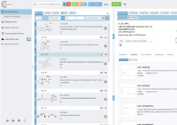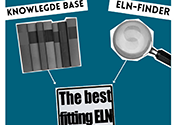Electronic Lab Notebooks ELN
The paper-based laboratory notebook is still widely used, and the way chemical research data is documented has hardly changed for a century. The progress of information technology in the laboratory (Smartlab) involves more than just tablets and touchscreens. It is about networking the entire workflow and handling research data according to the FAIR principles.
Electronic lab notebooks (ELNs) enable researchers to enrich experiments with extensive metadata and make the collected data traceable and reusable. The direct transfer of measuring devices to the ELN makes it the central repository for all data, which can then be easily published in repositories and transferred to long-term archives.
A key difference between ELNs and paper is the structured documentation of metadata that humans and machines can read. You can find further differences between simple systems, ELNs and laboratory information management systems (LIMS) in the knowledge base.

Screenshot of Chemotion ELN
Advantages of an ELN
- ELNs link test descriptions directly to the collected data so that all information is available in one place.
- Secure data storage and backups prevent data loss.
- Centralised storage facilitates knowledge management and access to data, including for new members of a research project.
- The biggest advantage of an ELN is the structured and standardised storage of metadata, which facilitates the publication of research results and the transfer of data to repositories.
More Info
- Dive deeper in our knowlegde base
News around ELN
 Developments SmartLab & Repositories - News from our tools - the next steps with our ELN and Repositories.
Developments SmartLab & Repositories - News from our tools - the next steps with our ELN and Repositories.  Sustainable research through digital lab environments - New Podcast by Nicole Jung and Joachim Richert
Sustainable research through digital lab environments - New Podcast by Nicole Jung and Joachim Richert  Making it easier to find the right ELN - NFDI4Chem and the ELN-Finder at TU Darmstadt strengthen collaboration
Making it easier to find the right ELN - NFDI4Chem and the ELN-Finder at TU Darmstadt strengthen collaboration  Practical RDM in University Education - Lessons learned from a research data management workshop at the consortium meeting in Halle.
Practical RDM in University Education - Lessons learned from a research data management workshop at the consortium meeting in Halle.  Chemotion Hackathon 2024 - In June 2024, a hackathon took place at the TU Braunschweig with members from 4 working groups for Theoretical Chemistry.
Chemotion Hackathon 2024 - In June 2024, a hackathon took place at the TU Braunschweig with members from 4 working groups for Theoretical Chemistry.  Updates on Chemotion Repository - In this version, we've enhanced the data transfer process for greater efficiency and reliability, along with several other updates and improvements.
Updates on Chemotion Repository - In this version, we've enhanced the data transfer process for greater efficiency and reliability, along with several other updates and improvements.  Saving time with ELN and Repositories - 3 use-case stories help to understand, how and why using an ELN and a repository doesn't cost time, but saves it.
Saving time with ELN and Repositories - 3 use-case stories help to understand, how and why using an ELN and a repository doesn't cost time, but saves it.  Ivan Vilotijević on Electronic Lab Notebooks - About the advantages of using an electronic lab notebook and experiences of introducing it in a research lab.
Ivan Vilotijević on Electronic Lab Notebooks - About the advantages of using an electronic lab notebook and experiences of introducing it in a research lab.  Integrating digital literacy into teaching - Interview with Prof. Dr. Georg Manolikakes from the RPTU Kaiserslautern, how to teach digital tools in a practical course.
Integrating digital literacy into teaching - Interview with Prof. Dr. Georg Manolikakes from the RPTU Kaiserslautern, how to teach digital tools in a practical course.  Another ELN made available for testing - The website demo.chemotion.scc.kit.edu/ provides a collection of test versions of various electronic laboratory notebooks (ELNs).
Another ELN made available for testing - The website demo.chemotion.scc.kit.edu/ provides a collection of test versions of various electronic laboratory notebooks (ELNs). 